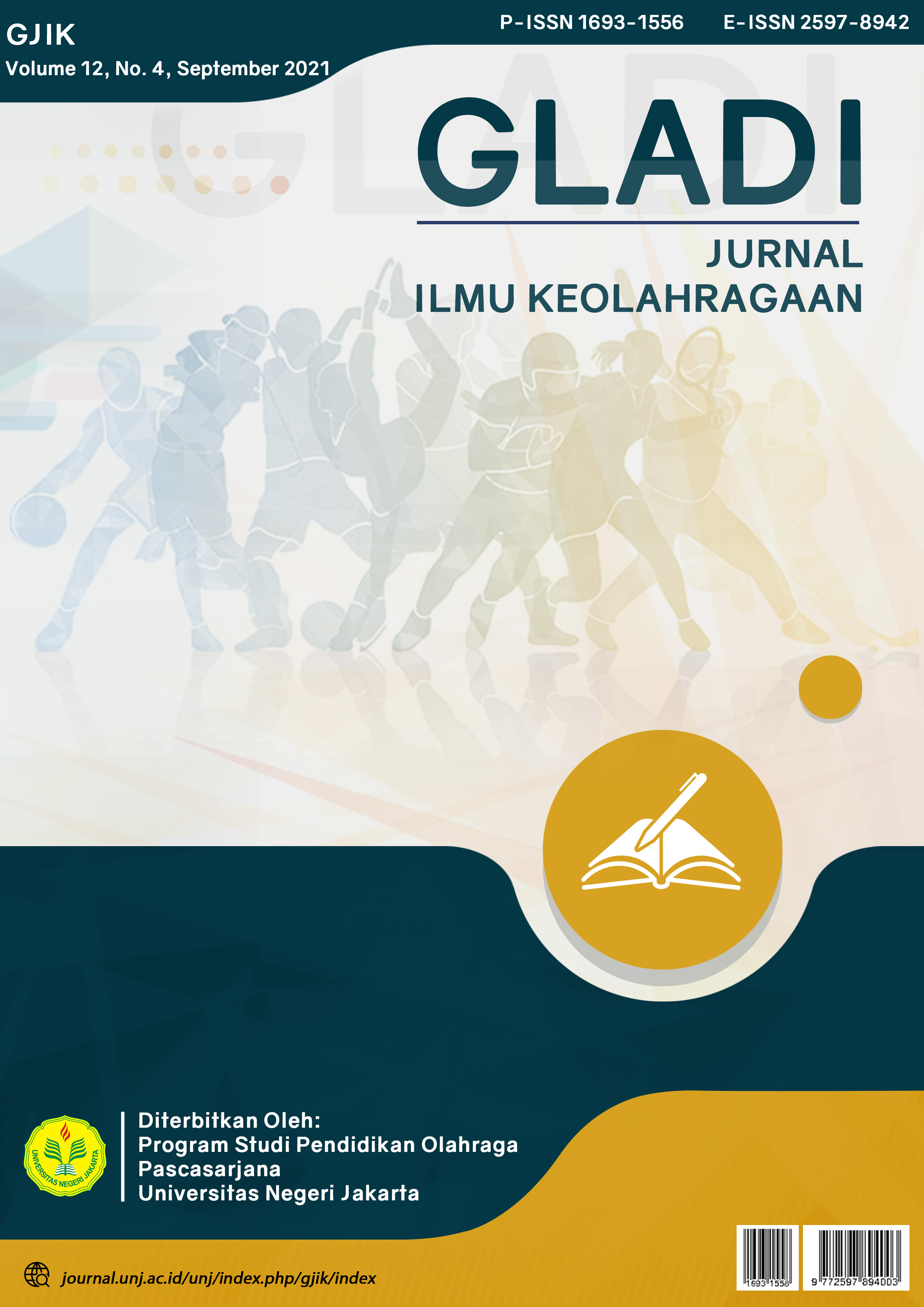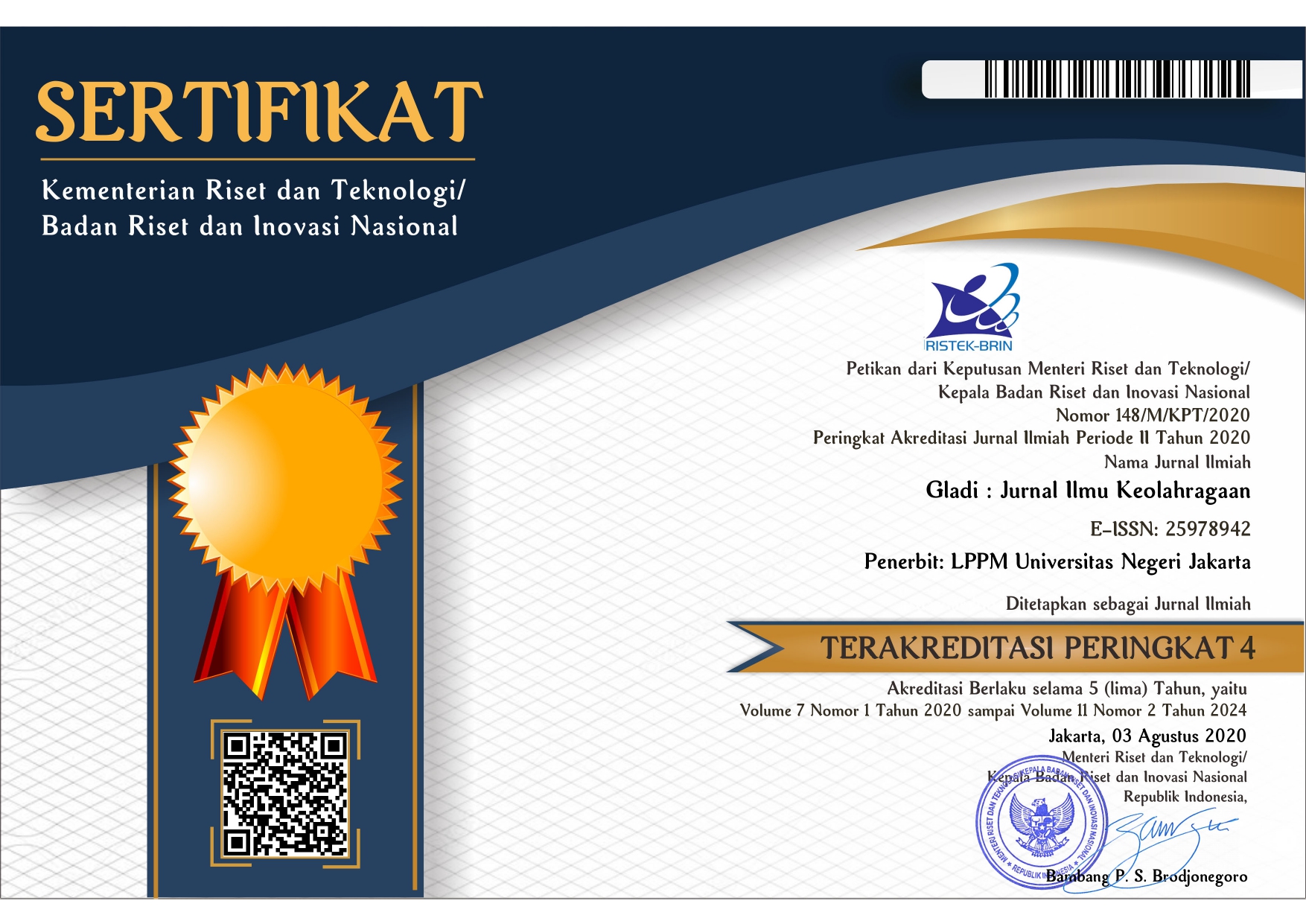GAME-BASED SOCCER TRAINING MODELS FOR CHILDREN AGED 6-8 YEARS
DOI:
https://doi.org/10.21009/GJIK.124.07Keywords:
Children, Football training, fun games, fundamental movementAbstract
The purpose of this study was to produce and develop a game-based soccer training model for children aged 6 - 8 years and to test its effect on improving children's basic abilities. This study uses the Research and Development (R&D) method from Borg and Gall with 10 stages; 1) research and information; 2) planning; 3) developing superior product forms; 4) preliminary field testing; 5) major product revisions; 6) main field testing; 7) operational product revisions; 8) operational field testing; 9) final product revision, and 10) dissemination and implementation. The subjects in the small group trial were 12 students of SSB Ina Football Soccer School Ciganjur, South Jakarta, and the subjects in the large group trial were 30 students, each consisting of 15 students of SSB Garuda Muda Batipuah, Tanah Datar, and 15 students of SSB Padang Laweh, Agam. . Whereas in the effective test using the subject as many as 30 students of SSB PS Marapi Batu Palano. The strength test of the game-based football training model for children aged 6 - 8 years using a basic motion test instrument, namely TGMD-2, consists of locomotor and manipulative basic motion tests. Data analysis obtained the mean value of the initial test 19.8 for basic locomotor motion and 7.4 for manipulative, and the final test mean value 34.9 for locomotor basic motion and 10.93 for manipulative. The significance test gets a t-count value of 26.87 for locomotor and 12.89 for manipulative, where each is greater than the t-table value of 1.699 at the 0.05 level so it can be denied that the game-based soccer training model has a positive impact and significant to the improvement of the locomotor and manipulative basic development of children aged 6 - 8 years. So that the conclusion that there are 33 game-based football training models is effective and significant for improving the basic motion of children aged 6 - 8 years and the training model is feasible to use and disseminate.
Downloads
References
Asian Football Confederation. (2013). AFC Grassroots Fun Football Course (6 – 8 years old). Kuala Lumpur: Asian Football Confederation.
Avry, Yvon, Bernet, Marco, Corneal, Alvin, Malouche, Belhassen, & Thondoo, Govinden. (2012). FIFA Grassroots. Switzerland: RVA Druck und Medien
Arisman. (2019). Pengaruh Latihan Square Terhadap Daya Tahan Aerobic Atlet Sriwijaya Archery Club. Jurnal Pendidikan Jasmani dan Olahraga, Volume 2, Nomor 2, Januari-Juni 2019, doi:10.31539/jpjo.v2i2.720
Asnoto, Bambang Triaji, Firmansyah Dlis, Sri Nuraini. (2020). Model Variasi Latihan Dasar Passing Sepakbola Putra Usia Kelas Tinggi Pada Sekolah Dasar. Gladi Jurnal Ilmu Keolahragaan, DOI: https://doi.org/10.21009/GJIK.112.01
Bakhtiar, Syahrial. (2015). Merencanakan Pembelajaran Gerak Dasar Anak. Padang: UNP Press.
Balyi, Istvan, Way, R., Higgs, C. (2013). Long-term Athlete Development. Canada: Human Kinetics.
Bompa, T.O., & Haff, G.G. (2009). Periodization Theory and Metodeology of Training fifth edition. United State: Human Kinetics.
Burton, Allen W., & Miller, Daryl E. (1998). Movement Skill Assessment. United State: Human Kinetics.
Canadian Sport Centres (n.d.). Developing Physical Literacy, a Guide for Parent of Children Ages 0 to 12. Canada: Canadian Sport Centres.
Canadian Soccer Association. (n.d.) Willness to World Cup, Long-Term Player Development. Canada: Canadian Scoccer Association.
Department of Education of Victoria (2009). Fundamental Motor Skills, A manual for Classroom Teachers. Melbourne: Department of Education.
Emral. (2017). Pengantar Teori dan Metodologi Pelatihan Fisik Edisi Pertama. Depok: Kencana.
Harsono. (2018). Kepelatihan Olahraga. Bandung: PT Remaja Rosdakarya.
Kurniawan, Rama (2018). Analisis gerak dasar anak usia 6 – 7 tahun. Jurnal Pendidikan Usia Dini UNJ. Doi.org/10.21009/JPUD.122
Marlina Siregar, Nofi. (2013). Teori Bermain. Jakarta: Program Studi Olahraga Rekreasi Fakultas Ilmu Keolahragaan Universitas Negeri Jakarta.
Mikail, Kafung dan Suharjana (2019). Pengembangan Model Latihan Teknik Dasar Sepakbola Bagi Anak Usia 10 – 12 Tahun di Sekolah Sepakbola. Jurnal Olahraga Prestasi (JORPRES), 15(1), 2019, 14-27
Nuraini, Sri dan Hartman Nugraha. (2018) Teori dan Praktek Permainan Kecil. Jakarta: LLP Press Universitas Negeri Jakarta
Rosinar, Siregar, Andi Ali Saladin (2018). Pengembangan Model Pembelajaran Gerak Dasar Berbasis Permainan Tradisional Siswa Kelas Tinggi di Jakarta Timur. Prosiding Seminar dan Diskusi Nasional Pendidikan Dasar 2018. ISSN:2528-5564..
Rusijono dan Mustaji. (2008). Penelitian Teknologi Pembelajaran. Surabaya: Unesa University Press.
Sari, Eka Fitri Novita. (n.d). Pola Asuh Orang Tua di Dalam Aktivitas Bermain Anak (Studi Terhadap Mahasiswa Fakultas Ilmu Keolahragaan Universitas Negeri Jakarta). Jurnal Olahraga Universitas Negeri Jakarta
Sari, Eka Fitri Novita. (2014). Parenting and Fundamental Movement Skills. Asian Social Science; Vol. 10, No. 5; 2014
Sari, Eka Fitri Novita, Sujarwo, dan Sukiri (2019). Basic Locomotor Movement of First Grade Students of Elementary School. Advances in social science, education and humanities research, volume 362 5th International Conference on Physical Education, Sport, and Health (ACPES 2019).
Sugiyanto. (2002). Perkembangan dan Belajar Motorik. Jakarta: Pusat Penerbitan Universitas Terbuka.
Sugiyono. (2015). Metode Penelitian & Pengembangan Research and Development. Bandung: Alfabeta.







